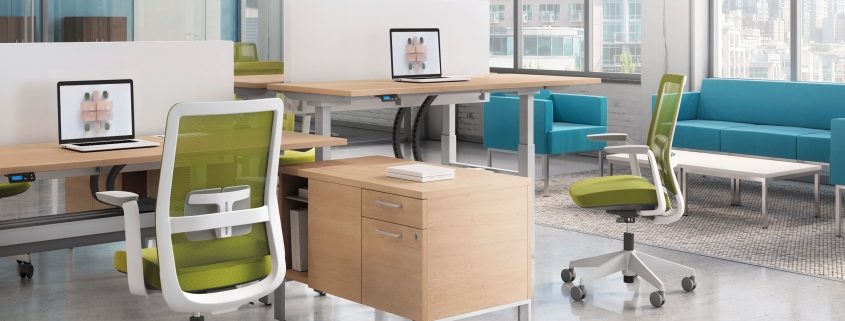Getting Comfortable With Your Office Chairs
Selecting comfortable office chairs is the single best investment you can make in your team. Task chairs are the foundation of office ergonomics. Task seating is specifically designed to handle the daily grind of sitting for 8+ hours a day. Correct body support through ergonomic design is a must to avoid back, neck and shoulder pain. Let’s take a look at the anatomy of the task chair and how each component works together to provide support for your daily tasks.
COMFORTABLE TASK CHAIRS
Base
The typical task chair base is five legs centered on a single post, and each leg contains a caster. The post and base support the seat and the legs balance the casters to provide free range of motion.
Hydraulics
The pump resides beneath the seat and allows you to raise and lower the chair, adjust the angle of the back and alter the lumbar support. When it comes to ergonomic chairs, having the ability to adjust the seat height is important. It controls the angle at which your knees and elbows rest. Ideally, you want your knees to always be at 90-degree angles to support your back without straining your knees. Additionally, you have to have your feet planted on the ground to assume the ideal posture. A seat that’s too low or too high prevents you from sitting in a way that supports your frame.
Seat
Your chair should have a comfortable body-hugging seat. Task chairs today come in a variety of shapes and materials, each of which provide various benefits to help improve your posture. Contoured seats encourage you to sit up straight and ease your back into lumbar support
Back
Ergonomically designed chairs feature curved backs that mimic the S-shape of the human spine. Fitting the natural curve of the spine will help you maintain the correct posture for sitting for long periods of time.
Arms
Armrests help you type more comfortably. Ideally, your elbows should rest at 90 degrees so you don’t have to hike your shoulders up or lean forward to access your keyboard. Additionally, the armrests must support your arms near the elbows, rather than near the wrists. most task chairs allow you to adjust the height of the arms to better conform to your body – after all, everyone is built differently. Some chairs even have curved arms to better hug your body.
MAKING ADJUSTMENTS
Comfortable office task chairs differ from other chairs in that they provide the body with additional support and stability. In an office setting, ergonomic features foster a neutral, comfortable working posture. A good chair height supports the thighs evenly and allows the feet to sit flat on the floor. Taking some time to make the proper adjustments for your personal task chair can make your day more comfortable.
Height: Stand up in front of the chair and raise or lower it so that the top of the seat cushion when parallel to the floor is at a height just below the knee cap.Sit down on the chair with feet flat on the floor. Ensure there is about 2 inches of clearance between the front edge of the seat and the calves. Achieving this may require you to adjust the tilt.
Tilt: In general, a slightly forward tilting chair is the most comfortable for basic computer usage. However, variation is key to avoid placing continuous pressure and strain on certain parts of the body. Tilt should be adjusted regularly to mix up position. Select an ergonomic office chair that is highly flexible and easy to adjust quickly while still providing a frame that disperses pressure and allows the feet to sit flat on the floor.
Arm Rests: Adjustable armrests are an important feature to ergonomic office chairs. Improper arm positioning can lead to strain in the neck and shoulders. Proper armrest height for good ergonomics should be at around the same height as the point of one’s elbow when bent at a 90-degree angle, according to OSHA. This positioning allows forearms on the rests with the arms slightly lifted at the shoulders, taking the weight off the shoulders and shifting it to the elbow
- Too Low: The user might be more inclined to slouch forward to rest his or her limbs.
- Too High: The user may be forced to hunch the shoulders when placing the forearms on the rests.
Lumbar Support is the most essential feature of an ergonomic office chair. Lumbar support minimizes tension on the back and prevents slouching. The aim is to match the backrest to the contour of the spine when seated in a neutral position. You may need to adjust the backrest by raising or lowering it so that it fits snugly in the natural curvature of the spine and pushes the back forward.
DESIGN
Office chairs have come a long way in design and style and can match just about any concept you can imagine. In addition to their highly functional contribution to productivity, they can become a brand spokesman for your colors and a fashion statement for your décor. Collaborative offices, sit-stand desking and executive office suites can develop their own seating personalities. Our showroom has a wide variety of task chairs to get you started in the right direction.
 VISIT OUR SHOWROOM for a rotating selection of items to choose from for your home office update! We have a range of chairs, desk systems, and case goods to create a unique work experience for your home office. Contact us at 512-448-3769 or experts@officefurniturenow.com
VISIT OUR SHOWROOM for a rotating selection of items to choose from for your home office update! We have a range of chairs, desk systems, and case goods to create a unique work experience for your home office. Contact us at 512-448-3769 or experts@officefurniturenow.com



